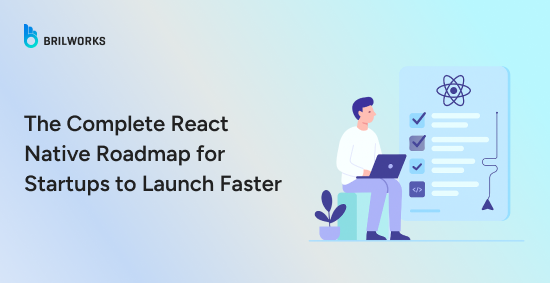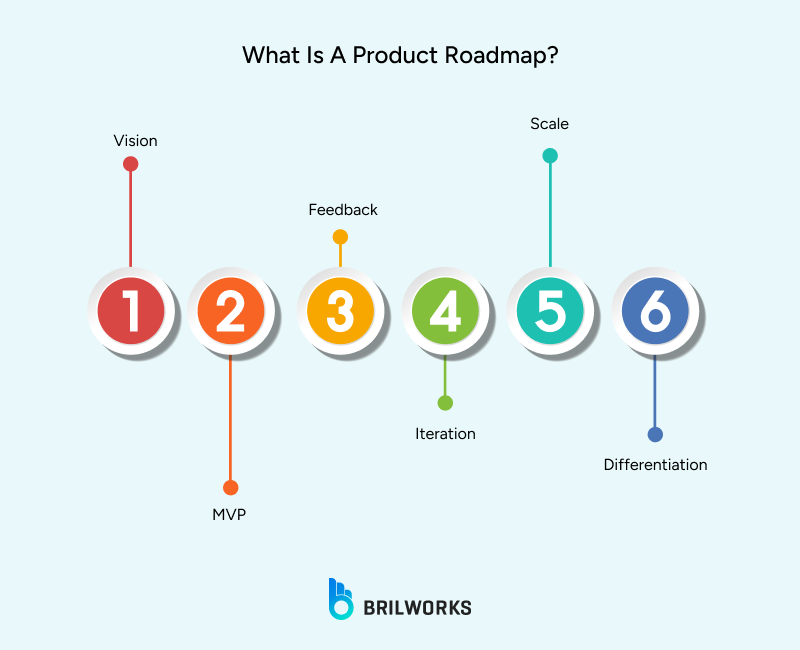COOPERATION MODEL
ARTIFICIAL INTELLIGENCE
PRODUCT ENGINEERING
DevOps & Cloud
LOW-CODE/NO-CODE DEVELOPMENT
INDUSTRY
FRONTEND DEVELOPMENT
CLOUD DEVELOPMENT
MOBILE APP DEVELOPMENT
LOW CODE/ NO CODE DEVELOPMENT
EMERGING TECHNOLOGIES








The success of a product depends on how well the company plans and executes its journey. Every startup wants to launch fast and grow without wasting resources. That is why many begin with an MVP. An MVP helps validate the idea and shows how the market responds. For this stage, startups often choose React Native app development because it fits the requirements for quick development and lower cost.
React Native for startups is more than a framework for building MVPs. Once the MVP is live, the next step is scaling. This is when you move beyond MVP and start building the complete app. The question many founders have is whether React Native is still a good choice at this stage.
This is where a product roadmap becomes essential. It gives structure to your plan from MVP to a full product. In this blog, we will explain what a roadmap is, why it matters, and how React Native supports every stage of it. We will also look at how to create a React Native roadmap that takes you from idea to successful launch.
Looking for a react native app development company that can turn your mobile vision into high-performance apps? Let’s create something users love—cross-platform, fast, and future-proof.

A product roadmap is a plan that shows how your product will evolve over time. It gives direction to your team and helps everyone focus on what matters most. For startups, this is important because resources are limited and every decision has a cost.
Without a roadmap, it is easy to get lost adding features that do not align with your long-term goals. A roadmap keeps priorities clear. It helps you decide what to build first, what can wait, and how to move from an MVP to a complete product. It also helps in communicating your vision to investors and stakeholders so they see the steps you are taking to reach the market.
For startups building apps with React Native, a roadmap ensures you make the most of the framework’s flexibility. It lets you plan for both quick releases and future scaling without running into unexpected challenges.

A roadmap is more than a list of features. It is a plan that helps you decide what to build, when to build it, and how to scale without wasting resources. Here are the key steps to create a strong product roadmap:
Every roadmap begins with clarity on what your product should achieve. Define the problem you are solving and the outcome you want for your users. This vision will guide every decision as you move from MVP to a complete product.
The next step is identifying the features that matter most for validating your idea. Keep it focused. Your MVP should deliver the core value without unnecessary complexity. This first release helps you test assumptions and understand real user behavior before investing heavily in development.
Once the MVP is live, gather insights from actual users. What do they like? What is missing? Use this feedback to shape your next set of features. The roadmap should always reflect market reality, not just internal ideas.
Growth requires planning. Include milestones for performance improvements, design updates, and advanced integrations. Make space for changes as your product evolves. A good roadmap is flexible, adapting to your goals and the market response while keeping everyone aligned on priorities.
This roadmap determines your development timeline. Refer to our blog for tips to speed up your mobile app development timeline.

A product roadmap moves through different phases, and each phase has a different goal. Here is how React Native supports those priorities at every step.
Priority: Speed and cost efficiency.
At this point, your main goal is to test the idea without burning your budget. Every week counts because you want to reach the market fast. React Native development helps you do this with one shared codebase for iOS and Android. This means fewer developers, faster delivery, and a smaller initial investment. Making this choice early can save weeks of work and thousands of dollars. Read our detailed guide on how to create an MVP with React Native.
Priority: Learning from real users and adapting fast.
Once your MVP is live, your next move is guided by feedback. Users will request features, and competitors will keep evolving. You need a way to respond without slowing down. React Native makes iteration easier with Hot Reload and shared logic across platforms. This reduces the time it takes to test and release updates, helping your roadmap stay flexible and responsive to the market.
Priority: Stability and user experience.
A polished app is critical before scaling. At this stage, design quality and performance influence user retention. React Native offers native components and supports advanced features through native modules, so your app feels close to native without a complete rewrite. This gives your team more time to focus on UX improvements rather than rebuilding the core app. Moreover, there are many React Native UI libraries to help you with this.
Priority: Performance and scalability.
When growth accelerates, performance becomes a business issue, not just a technical one. Downtime or lag can affect revenue and user trust. React Native allows performance flexibility, offers the ability to integrate native code where needed, optimize heavy processes, and maintain a single codebase. You avoid the cost and delay of maintaining two separate apps, which keeps your roadmap on schedule as the user base expands.
A fitness startup wants to validate its idea quickly. Using React Native, the team builds core features like user profiles and workout tracking for iOS and Android in a few weeks instead of months.
After launch, users ask for social sharing and personalized workout plans. With React Native, the team rolls out these updates fast without hiring separate teams for each platform.
As the app gains traction, the startup focuses on improving design and ensuring stability. React Native allows them to integrate advanced UI elements and animations while keeping performance strong.
The app grows to thousands of users. To improve performance, the team integrates native modules for heavy tasks like video streaming. They do this without rewriting the app, which keeps the product roadmap on track.

A roadmap is more than a timeline. It is the blueprint that takes your product from concept to a full-fledged app without wasting resources. For startups, a well-defined React Native roadmap ensures you stay aligned with business goals at every stage. Here is a practical roadmap that you can adapt for your own journey.
Before writing any code, you need clarity. Decide what problem your app will solve and what result you want in the first year. A clear vision helps you make better choices and stops you from adding features that do not fit your goal.
Startups that skip this step often end up changing direction later, which takes more time and resources. Defining your vision keeps the roadmap simple and focused.
Key takeaway: Write a one-page note that explains your app’s purpose, target users, and success metrics for the first year.
The MVP stage is about speed and learning. You want to launch quickly and check if your idea works in the market. React Native app development for startups makes this possible because you can create apps for iOS and Android with one codebase, which saves time and money.
Keep your MVP small. Focus on the main feature that solves the core problem. Do not add extra features like advanced animations or third-party services at this stage. For example, if you are creating a fitness app, start with user registration and basic workout tracking.
Key takeaway: Limit your MVP to one or two main features that give real value and can be built in six to eight weeks.
After the MVP is live, the focus is on learning from users. Check which features they use most and where they face problems. Collect feedback through surveys, email, or beta groups.
React Native helps in this stage because it allows you to make quick changes without managing two separate apps. You can reuse components and ship updates faster, which keeps your product moving forward.
Key takeaway: Plan small and frequent updates instead of big releases. This makes it easier to adapt and keep users engaged.
Once the MVP proves the idea, the next step is to make it ready for a full release. At this point, design and performance matter more. Improve the interface, add important features that users expect, and make sure the app works well on all devices.
React Native supports this stage because you can add native modules for advanced features without rebuilding the app. This gives you flexibility while keeping the benefits of one codebase.
Key takeaway: Before release, check that the app is stable, fast, and secure.
When your user base grows, your focus should be on performance and architecture. Growth is not only about adding new features. It is about making sure the app handles more traffic and remains stable. Optimize your backend, add caching, and improve the structure for future updates.
React Native for startups makes scaling easier because you do not have to manage two different apps. You can still add native code when you need better performance.
Key takeaway: Review your app’s architecture every few months to make sure it can handle growth.
This roadmap is not fixed. Review it often and update it as your business and users change. A clear plan like this helps you move from idea to scale without wasting time or resources.
Building a mobile app is more than writing code. It takes planning, design, testing, and a good understanding of how to scale when the time comes. Many startups want to do everything in-house, but often face delays or run into technical challenges that slow down progress. Also they have to keep in mind the cost of development as well.
Working with a React Native app development company can make the process easier and more predictable. These teams have experience building apps across different industries and know how to avoid common mistakes that cost time and money. They understand the best practices for React Native and can guide you through each stage of the product roadmap without unnecessary complexity.
Here are a few ways this helps:
Faster delivery because the team already knows the framework inside out
Lower risk of technical debt with the right architecture from day one
Access to experts without the cost of building a large in-house team
Guidance on scaling and integrating native features when needed
For many startups, this approach keeps the roadmap on track and reduces the pressure on internal teams. It lets you focus on your business while the technical side is handled by professionals who do this every day.
A product roadmap keeps your startup focused and gives structure to every stage of app development. React Native fits well into this process because it helps you launch faster, adapt to feedback, and scale without starting from scratch.
If you want to move quicker and avoid common mistakes, working with experienced developers can make a real difference. Many startups choose to hire React Native app developers to speed up delivery and keep the roadmap on track without compromising quality.
React Native allows startups to build high-quality apps for both iOS and Android using a single codebase. This saves time, reduces costs, and accelerates time to market without compromising user experience.
With features like hot reloading, pre-built components, and third-party plugins, React Native simplifies and accelerates the development cycle. Startups can quickly iterate and release MVPs faster than with traditional native development.
Typical stages include planning the MVP, setting up the development environment, designing UI/UX, writing code, testing, and deploying the app. Post-launch maintenance and scaling are also part of the roadmap.
Yes. Many successful startups have scaled their apps with React Native. With the right architecture and optimization practices, it supports growing user bases and evolving feature sets.
Startups can work with experienced development companies or hire dedicated React Native developers. Look for teams with proven portfolios, expertise in startup-centric solutions, and the ability to support product evolution.
Get In Touch
Contact us for your software development requirements
Get In Touch
Contact us for your software development requirements